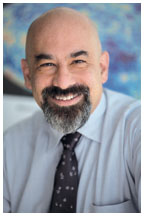
|
April 19, 2006: A moment with...
David Spergel ’82
(Photo by John Jameson ’04) |
Adorning David Spergel ’82’s office door is a cartoon depicting two scientists in full lab regalia, hard at work. The caption: “Sometimes I wonder if there’s more to life than unlocking the mysteries of the universe.” The cartoon is especially appropriate for Spergel, a Princeton astrophysics professor who was part of a research team that released groundbreaking results last month in support of inflation theory, a model that explains the growth of the universe following the Big Bang. The findings resulted from a NASA satellite called the Wilkinson Microwave Anisotropy Probe, or WMAP (named for the late Princeton physicist David Wilkinson) that measures the microwave background radiation in the universe — essentially, the heat that remains from the Big Bang about 13.7 billion years ago. Spergel spoke with PAW contributor Hilary Parker ’01. (For pictures and more information, visit http://map.gsfc.nasa.gov/m_mm.html.)
For the nonscientists among us, what is inflation theory?
Inflation theory was an idea developed about the time I was an undergraduate. It posited that the universe underwent a period of very rapid expansion where the size of the universe grew exponentially during the first trillionth of a second. The universe started out expanding rapidly, and then slowed and entered the normal expanding phase.
The giant explosion that was the Big Bang propelled some parts of the universe out faster and farther than others. Your results show greater fluctuations in temperature and density between points that are farther apart than between those that are closer together. How does that support inflation theory?
To get from the rapid expansion to the normal expansion phase of the universe, expansion had to slow and the amplitude of fluctuations had to decrease. The inflation model predicts that the fluctuations in density and temperature should be larger on [distance] scales of 1 to 10 billion light-years, and slightly smaller on scales of 100 million to 1 billion light-years. What we have shown now is that the fluctuations vary with scale. A modern-day analogy would be, if I’m driving along in a car at 90 miles per hour and I jiggle the steering wheel, it’s going to have a big effect on the car’s motion. It’s not the same if I jiggle the wheel at 3 miles per hour.
What was your initial response to the results?
Excitement, followed by doubt. I wanted to be convinced that they were really there. Three years of careful checking have me convinced.
The WMAP measures the microwave background radiation generated 400,000 years after the Big Bang. What can this tell us about the universe?
When we’re looking at the microwave background, the physical analogy is to think about a lake, and throwing rocks and pebbles into a lake. We’re observing the ripples. We can learn how many rocks and how many pebbles were thrown into the lake and the properties of the lake itself. Now we’re learning the properties of the universe itself. The important concept to have is that when we look out in space, we look back in time. We’re actually looking back 13.7 billion years. We can use the microwave background to connect to how the universe is growing today, looking forward in time; and looking back in time to the first moments of expansion.
Is it overwhelming to contemplate such big ideas?
In a sense during my working time, I spend more time thinking about the little pieces you need to understand to get at the big concepts. Every now and then I sit back and think about the big concepts, and they’re pretty awesome. I think the questions that we’re addressing — how old is the universe, what is it made of, where did it come from — are questions that everyone asks, and we’re fortunate to be able to address them with an experiment.
The WMAP is named in honor of David Wilkinson, the late Princeton physics professor, and many Princetonians have been involved with the research. Are there other Princeton connections?
It is very much a Princeton project. Princeton played a major role not only in the construction of the satellite but in the training of the people. Microwave background radiation was first discovered at Bell Labs but confirmed here by this lab. Dave then spent most of the rest of his career here studying microwave background radiation and training a generation of undergraduate and graduate students who would go on to become leaders in the search.
How did Princeton help launch your career in astrophysics?
When I came to Princeton I was debating between physics, astronomy,
math, and the Woodrow Wilson School. Now, I’m serving as chair of
NASA’s advisory committee on astrophysics — I help advise
NASA on science policy and make recommendations on science priorities
— and I go down to Washington, D.C., reasonably often, so I guess
I’ve combined my interests. ![]()

